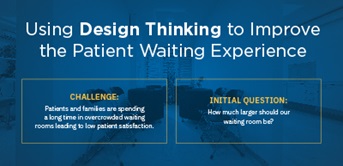In Brief
A day at Disney World is very different from a visit to any other amusement park. Most amusement parks offer similar physical elements like rides, games, activities, characters and food, but unlike the others which tend to focus on the physical elements of the park, Disney also pays close attention to the intangible, emotional aspects. This leads to more positive memories and a better emotional experience for visitors. In the same way, many hospitals look similar and offer similar services, but the patient experience can vary significantly. With design thinking, a framework for solving problems that address the tangible and intangible aspects of an experience, healthcare organizations can create a superior patient experience, just like Disney World has created a superior amusement park experience.
Understanding the Design Thinking Framework
Design thinking is a problem-solving methodology that emerged as a way to create products and services that better fulfill the needs of the end user. Applying this framework in healthcare solves problems and creates new processes centered on the needs of key stakeholders. Design thinking empowers employees and patients to play an active role in solving challenges. By focusing on functional and emotional needs, staff and patients weigh in on their encounters from a physical perspective (their sensory experiences) along with the emotions they had during a given experience. This paints a more complete picture and leads to solutions that address the needs of key stakeholders in a more holistic manner.
Design Thinking in Action
For leaders, it can be easy to address the functional aspects of a problem. This may lead to a quick solution, but it does not always provide the benefits you hope it would. In contrast, research has found design thinking to be effective in fostering new approaches to complex and persistent healthcare problems through human-centered research, collective and diverse teamwork, and rapid prototyping.
Many process improvement frameworks will move metrics in a positive direction. For instance, when a hospital wants to create a better emergency department (ED) experience, leaders may focus on wait times by streamlining the triage process to shorten wait times. However, for patients this shorter wait time may not make their experience better if they’re sitting in a waiting room that is dirty, overcrowded and loud. By implementing a design thinking framework, patients’ physical and emotional experiences would be considered in the creation of a solution that is less focused on shorter wait times but addresses the entire wait experience for the patient and their family. At Disney World distractions for those in line for rides help pass the time and make the long wait times feel not so long. Similarly, a hospital can create a better experience by adding amenities that distract individuals and create a calm environment, and investing in technologies that allow patients and families to leave the waiting room area to go to other parts of the hospital, like the cafeteria.
Design thinking offers the following benefits:
- Increases employee and patient satisfaction
- Eliminates process inefficiencies
- Creates sustainable and realistic solutions
- Develops solutions that focus on improving the overall experience, not just improving efficiency metrics
By engaging key stakeholders including nurses, physicians, other staff members plus patients and their families in a design thinking process, leaders can discover the root factors that cause a problem and work collaboratively with stakeholders to find a solution that creates a better experience. Staff are more likely to implement and sustain a solution if they play a role in its development which makes their engagement in developing solutions critical in ensuring that the patient experience improves.
Using Design Thinking to Improve the Patient Waiting Experience
In this infographic, learn how the design thinking framework improves the patient experience by creating a more patient-centric experience while they wait for their appointments.
Read More
How to Implement Design Thinking
- Build a multidisciplinary team. Identify people who have a stake in the problem you want to solve including patients, family members, nurses, physicians and individuals with an outside perspective on the issues at hand, as well as individuals with financial expertise and visualization skills.
- Cocreate. With this framework leaders engage key stakeholders in problem solving rather than finding a solution on their own. This gives employees ownership of the final solution.
- Use a four-step framework to solve a problem.
- Fact finding. Gather relevant information using qualitative analyses and quantitative measurements, and survey key stakeholders to gain a holistic understanding of a process from before it begins (anticipation of event) through completion (memories of event). The information gathered will paint a better picture of what actually occurs as well as the perceptions.
- Assess the jobs to be done. Information gathering often uncovers new or hidden factors that contribute to the problem. You may need to reframe the original problem you are trying to solve in order to address these factors and create a more impactful outcome.
- Identify solutions. Look at the factors that contribute to the problem and draw conclusions about the causes to develop new potential approaches.
- Prototype and learn. Identify and implement solutions on a moderate scale, and continually reevaluate and expand them over time.
Looking at areas of improvement through the lens of design thinking will create innovative approaches that develop more holistic solutions that take into account the tangible and intangible elements of an experience, rather than focusing only on processes and metrics without accounting for the emotional element.
